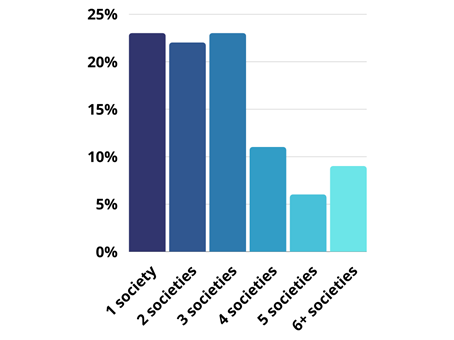multiple-society-membership-the-more-the-merrier
March 17, 2021
We know from six years of Wiley Society Member Surveys that overall, membership of scholarly and scientific societies has remained consistently strong at around 60% of respondents. The findings from our 2020 survey were no different - 62% of respondents are current members and 12% have been in the past. It turns out that membership of multiple societies was also extremely common, and we wanted to find out more. So, we asked members why they are likely to join more than one society to see what this could mean for a society’s membership strategy.
More memberships means more access
A typical society member belongs to 3 different societies, and in 2020 the number of members who belong to three or more societies increased from 41% to 49%. A surprising 9% of responders even belong to six or more societies! Members are also more likely to join another society if that society publishes a journal.
Multiple society membership is most common in the United States, especially amongst men with over six years’ experience. Usually, those who join multiple societies are satisfied with the membership benefits they’re getting such as access to content, career support, and interaction with the rest of the research community. The reasons for joining are numerous and varied, but one thing that doesn’t appear to be a factor is subject area, since we’ve seen this same trend across all disciplines.
Those who belong to fewer societies are often students, female, and based in the Americas. Since multiple membership seems to be connected to strong member satisfaction, societies might have an opportunity here to engage more with this group.
Rates of Multiple Society Membership:

What does this mean for societies?
Although membership rates overall may be holding steady, we’ve seen significant change in the last 12 months in response to Covid-19. Members will look for new societies to join or other ways to meet their needs if they aren’t getting right mix of benefits. When it comes to researchers right now, our surveys suggest offering virtual society conferences and support for open data.
After loss of funding and retirement, the main reasons people reported for leaving a society were “lack of professional value” (16%), followed by a “lack of support for education” (13%) or ”career advancement” (10%). Making sure society offerings in these areas are strong will help to keep members around.
It’s clear that society engagement is key to member satisfaction, especially during this time of rapid change and innovation. In today’s virtual world, members want to continue to feel connected through more informal channels of communication such as webinars, podcasts and videos. Societies who are successfully reaching this group with the right communication strategy will help increase satisfaction rates and keep their members interested. Multiple society membership is on the rise and should be encouraged, because those who are highly involved are happy with all they are getting out of their (many) memberships. The more the merrier!

